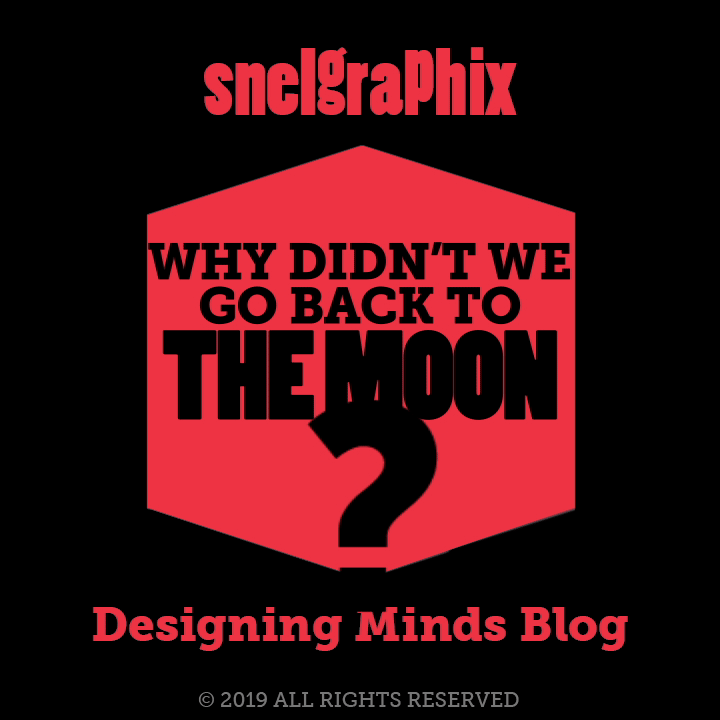Apollo 11 Astronaut Buzz Aldrin on the moon. 21 July 1969 • Wikimedia Commons
Why didn't we go back to the moon?
One of my sons asked me this question just the other day, inspiring this article. Without giving it much thought, I flippantly told my youngest child the answer might have to do with the same reason the original Planet of Apes film series lost popularity with subsequent sequels.* The audience had seen it already. Unless NASA’s brave astronauts were going to fight crater-dwelling aliens in outer space, like Flash Gordon or Buck Rogers, audiences were always going to become bored watching men in spacesuits jump up and down and drive around in glorified golf carts on the moon. NASA didn’t win any fans over when they showed the Apollo 14 astronauts hitting golf balls and leaving litter on the lunar surface. Maybe NASA should have sent three women into lunar orbit. I bet that would have grabbed even more global attention than Neil Armstrong’s and Buzz Aldrin’s footprints. I suppose NASA didn’t think anyone would want to watch women on the moon, despite the success German auteur Fritz Lang had with this exact idea.*
A year before the Apollo 11 launch, Arthur C. Clarke’s and Stanley Kubrick’s cosmic-odyssey masterpiece, shot in high-resolution Super Panavision 70 film,* brought cinemas full of audiences to the lunar surface and beyond. Meanwhile, television viewing audiences had just spent three seasons of NBC’s recently canceled Star Trek series, exploring staged new worlds. Dressed in vibrant television-friendly colored uniforms and armed with things like fancy walkie talkies and space guns capable of zapping non-lethal stuns, Captain Kirk and the international, mixed-gender crew took anyone watching a television set traveling not only into outer space, but through the time barrier, and into other Universes. NASA had a tough act to follow.
The Transporter nears the top of the five percent incline at Launch Complex 39A with the Apollo 11 Saturn V. 20 May 1969 • Wikimedia Commons
The Moon Landing Hoax Is Old News
“Just a month before, Apollo 11 astronauts Buzz Aldrin and Neil Armstrong had left their colleague, Michael Collins, aboard spaceship Columbia and walked on the moon...The old carpenter asked me if I really believed it happened. I said sure, I saw it on television.
He disagreed; he said that he didn't believe it for a minute, that 'them television fellers' could make things look real that weren't.
Back then, I thought he was a crank. During my eight years in Washington, I saw some things on TV that made me wonder if he wasn't ahead of his time." • Former President Bill Clinton
So, what was the real reason why we didn’t go back?
Of course, a crazy planetary conspiracy involving fakery on a massive scale, with the culprits leaving clues in the Hollywood films Capricorn One and Diamonds Are Forever, is out of the question.* I wouldn’t recommend confusing a few satirical asides with revelation. Hyperbole and parables are no substitute for physical reality. There were always people who doubted the moon landings happened, at least according to sources like former President Bill Clinton’s autobiography, tabloids like the National Enquirer, the absurd Flat Earth Society, and conspiracy theorists Bill Kaysing and Milton William “Bill” Cooper, Alex Jones’ mentor.* None of this nonsense is new, and despite what I told my son, the American public's dwindling interest was equally unimportant.* The coincidentally-numbered Apollo 13 mission wasn’t the reason either.* Even top-secret alien moon-bases weren’t stopping further expeditions.*
The boring down to Earth reality is that the United States Congress didn’t bother planning much past the Apollo 17 mission and started shrinking NASA’s budget, as early as 1969.* Even pre-resignation President Richard M. Nixon wanted to pay less for outer space exploration.* Maybe all those political folks in Washington D.C. were a bit too busy smoking some of the stuff the kids were puffing over at that hippie music festival in Bethel, New York.* As my paternal great-grandaunt* was fond of saying, “Some people just can’t handle the pot.” Maybe this explains that whole Watergate thing too. I don’t know; I‘m just guessing now. But the Watergate story is so weird I always figured President Dick Nixon had to be on something. Maybe Tricky Dick had ingested some of that infamous brown acid everyone used to talk about.*
Woodstock August 15, 1969 • Wikimedia Commons
The truth is NASA means progress.
Apollo 9 blasted into the sky on March 3, 1969. This was NASA’s first moon launch in that year and was the first time NASA sent both the command and the lander modules into lunar orbit. This penultimate test took place before the NASA termed “Apollo 10 dress rehearsal”.* 1969 would be the year life changed for everyone on Earth whether they knew it or not. This NASA mission and its subsequent sequel would prove that humans were getting closer to the day when someone would be shown stepping foot on another world, proving once and for all that Copernicus, Galileo, Kepler, and Newton were right. The physical laws that we must obey here on the surface of Earth are also naturally enforced in outer space.
Apollo 11 represents not one but twin achievements of our collective ingenuity. One of our greatest achievements was the conquering of physical space. The other towering human achievement was our interplanetary communication success. Can you imagine the looks on Marconi’s and Nikola Tesla’s faces were these two radio pioneers alive to watch the moon landing on television during the summer of 1969? We were able to not only send and receive radio transmissions from the moon, but we were also able to broadcast television live from the lunar surface.
Human beings build on what comes before. We have an instinct for building and its opposite. We construct new structures, demolish these structures when they no longer work for us, and rebuild new structures in their place. We change our minds even more often than we change our physical environments. We appear addicted to constant cycles of change. We used to spend generations of our lives engineering and constructing feats like cathedrals and pyramids that reached out towards the heavens, roads to Rome, and wooden ships to sail uncharted seas. Some centuries back, we replaced the Ptolemaic theory of an Earth-centered Universe with heliocentric reasoning. Many minds refined this new paradigm with mathematically descriptive work until humanity correctly modeled the solar system. We were then able to present predictive proof supporting this world-moving paradigm. We went from a medieval Church driven existence before the printing press produced the Age of Enlightenment, to the post-industrial electronic age in a matter of a mere five centuries.*
The moon landing would be humanity’s crowning accomplishment, demonstrating what we could achieve on an interplanetary scale.
The Tower of Babel by Pieter Bruegel the Elder (Vienna) 1563 • Wikimedia Commons
Outer Space is an international endeavor.
As it turns out, the truth is, everyone is in on it. Whether we want it to be true or not, and whether we know it or not, we’re all in this together. We’re all passengers on Spaceship Earth.* Civilizations aren’t constructed overnight. Civilization is a continuous project. We never stop building the future. Human progress never ends. We have spent centuries making our world more habitable for humanity.
During the summer of ‘69, we were heading off into outer space to explore our nearest solar system neighbor, the Earth’s only naturally occurring satellite, the mysterious Moon. Many of us can (sort of) remember that significant summer when NASA’s Apollo program exploded, shattering the sky. Television screens around the planet showed human feet touching the surface of another world for the first time. President John F. Kennedy’s vision of the lunar landing, expressed in his wonderfully worded speech at the start of the culturally revolutionary 60s, was perfectly executed by NASA by decade’s end as he had predicted. It’s as if the assassinated President had ridden in H.G. Wells’ time machine.* Sixty-nine months to the day, after that fatal day in Dallas, Life Magazine published the accounts of the three Apollo 11 astronauts.*
“Inner Space Suit with First Person Shooter Gloves”. NASA’s 1989 Virtual Reality Gear • NASA
NASA Develops Our Future
Imagination can solve nearly any problem. The ambitious scope of the moon missions meant NASA would have to find partners to work with to develop the technology they needed to shoot the moon. NASA’s investments have produced many new inventions* NASA and its private-sector allies are now promising a new 21st-century lunar landing program that they say will put us back on the surface of Earth’s moon soon. This sets the stage for more. The next leap forward will be colonizing Mars.*
In the meantime, NASA funded technological magic will virtually transport us across the solar system. Virtual reality promises to be as world-changing as the “Gutenberg Punch-Matrix Revolution” was. NASA and the computer industry have been working on this for decades.* This long-gestating technology is only now starting to come online. Our predicted future looks very promising. What an amazing time to be alive!
The Noble Lie Postscript
The Noble Lie Revisited with Jason Reza Jorjani – New Thinking Allowed


























